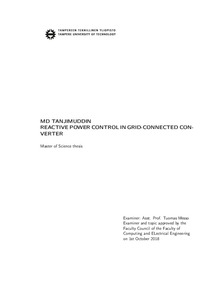Reactive Power Control in Grid-Connected Converter
Tanjimuddin, Md (2018)
Tanjimuddin, Md
2018
Electrical Engineering
Tieto- ja sähkötekniikan tiedekunta - Faculty of Computing and Electrical Engineering
This publication is copyrighted. You may download, display and print it for Your own personal use. Commercial use is prohibited.
Hyväksymispäivämäärä
2018-10-03
Julkaisun pysyvä osoite on
https://urn.fi/URN:NBN:fi:tty-201810032386
https://urn.fi/URN:NBN:fi:tty-201810032386
Tiivistelmä
During the last two decades, power system engineers are much concerned about the quality of power that is being supplied to the customers. Power losses at the lower level, compensating devices to balance the active and reactive power and overall stability of the power system is demanded. Thus, the present power system is now undergoing a severe transformation and expansion due to the available smart technologies, the evolution of renewables and for the rapid increase of electricity demands. Power electronics technology plays a vital role in the integration of renewables and minimizing power quality problems. The voltage source converter is one of the key elements in the power electronics field which make the significant contribution to incorporating renewables and lessening power quality problems. It is possible, due to its power conversion and power controllability features.
In this thesis, the reactive power control features in the grid-connected voltage source converter are implemented and verified through different simulations. The battery storage is used as the source of voltage during the thesis. In the implementation stage, the converter parameter and filtering technique are firstly selected, keeping in mind that the expected converter is at MW level. Later, grid synchronization and inner current control are implemented using a simple PI controller. To design the proper controller parameters, the dynamics of the converter is also analyzed. During the power control stage, conventional droop mechanism is applied to generate current reference in order to manipulate the reactive current that is generated by the converter. Manipulating the reactive current defines to what extent of reactive power is to be controlled regarding support grid voltage.
In this thesis, the reactive power control features in the grid-connected voltage source converter are implemented and verified through different simulations. The battery storage is used as the source of voltage during the thesis. In the implementation stage, the converter parameter and filtering technique are firstly selected, keeping in mind that the expected converter is at MW level. Later, grid synchronization and inner current control are implemented using a simple PI controller. To design the proper controller parameters, the dynamics of the converter is also analyzed. During the power control stage, conventional droop mechanism is applied to generate current reference in order to manipulate the reactive current that is generated by the converter. Manipulating the reactive current defines to what extent of reactive power is to be controlled regarding support grid voltage.
